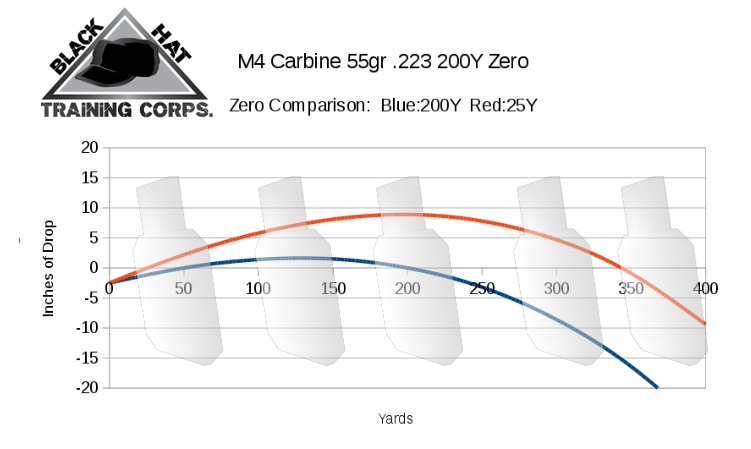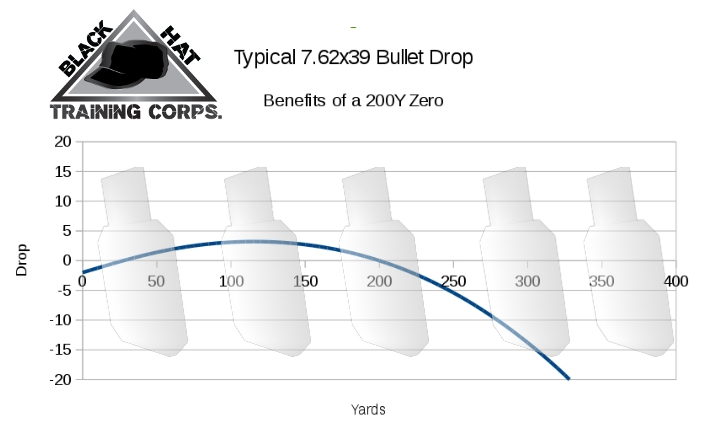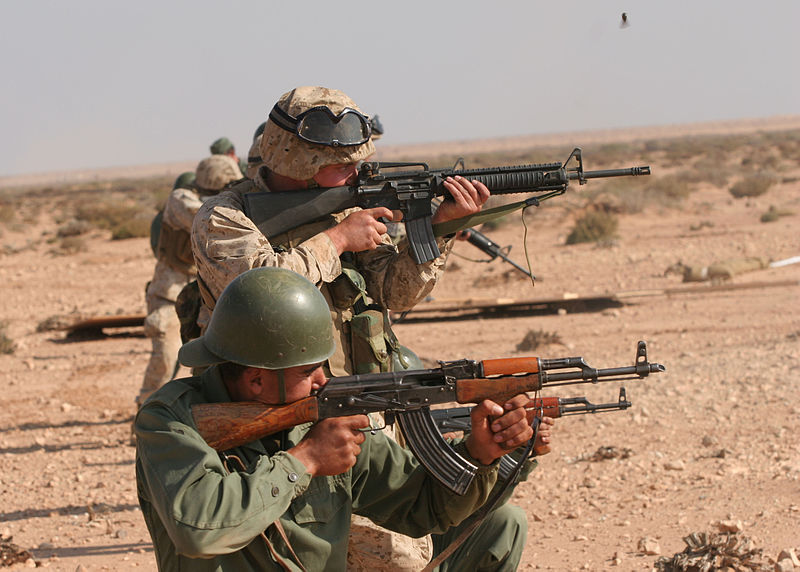Shooters often ask the question what’s the best way to zero my AR15 or Kalashnikov?
Often times, the answers given are confusing, and are seldom substantiated with science. You have probably heard that the Army does it a certain way, the USMC another way, and the Navy SEALs still do it yet a different way.
Each have their reasons, but when you look into them, you realize that they are much more for convenience than effect. For instance a 25Y zero is far from optimal for engaging IDPA sizes targets from 0-350 yards, but it starts to look mighty convenient when all you require to conduct it is a 25Y range.
Some blindly follow these practices, zeroing their rifles at distances that may wind up to be completely inappropriate for the type of shooting you intend to use the rifle for.
Rather than get into a debate about which one of our armed services has the best zeroing practices, at Black Hat Training Corps, we bring another seat to the head of the table, and we listen to what the bullet has to say. We present a case for zeroing that takes the best advantage of the ballistic performance of today’s modern sporting rifle calibers.
In our Initial/Intermediate Precision Rifle Course, we teach an extensive block of instruction on exterior ballistics and trajectory. A key principle of this is understanding that you can’t change what the bullet is going to do once it leaves the barrel. The trajectory is what it is. Because…. physics.
What we CAN do is apply the sights to take the best advantage of that trajectory. A 200Y zero accomplishes this with the vast majority of combat rifle calibers in use today.
Here’s what you’ll get with this zero:
- From the muzzle to 200Y, your impacts will not be greater from your point of aim than the height of your sight is over the bore.
- You can use a Center of Mass hold on an IDPA sized target past 300Y and still score a hit on it.
That’s the why. Now let’s look at the how.
First things first. Any combat rifle trajectory is going to have a “flat spot” within it. This will be the portion of the trajectory curve that is the least amount of deviation from our line of sight. Take a look at this image below. The flat spot of our M4’s trajectory is shown inside the cylinder.
Take a look at this illustration. The blue line represents a 200Y zero with a typical M4 carbine shooting a 55gr m193 type bullet. The red line is the same except we zeroed at 25Y. A 62 grain bullet will not deviate noticeably from this.
 Which one is making the best use of the trajectory’s “flat spot” to deliver center-of-mass hits at the more likely engagement distances?
Which one is making the best use of the trajectory’s “flat spot” to deliver center-of-mass hits at the more likely engagement distances?
This isn’t to say that a 25Y zero is unusable. It does work, but what happens at the maximum ordinate (which is the highest point on the trajectory)? Look carefully… It begins to coincide with the narrowest part of our target (the neck, and the head). With this zero and a center-of-mass hold, my bullet would spend about 200 full yards of it’s trajectory in the space where I can tolerate only the slightest error of aim. When you consider that versus the center-of-mass impacts that a 200Y zero delivers, it becomes far less of a contest.
If you don’t have a 200Y range to zero on, don’t worry, you can still zero at 50Y quite effectively. Note that our bullet crosses the line of sight at both of those distances. If you do this, you must be VERY precise in making your adjustments. Acceptance of the slightest error will be magnified four times when you take a 50Y zero and attempt to shoot at 200Y with it. If you have access to both distances, zero at 200Y, and ‘trust’ the 50Y rather than vice versa.
Zeroing The Kalashnikov
A Kalashnikov rifle firing a 7.62×39 FMJ cartridge happens to have the flat spot in roughly the same location.

I shoot Kalashnikov rifles all the time, and teach courses on this platform as well. The same zeroing principle holds true for this platform. The flat spots of the trajectory are in almost exactly the same place. You will get the most usable distance out of the rifle without having to make any sight adjustments with this technique.
So at the end of the day, you have to take a hard look at what your goals are. If hitting something roughly the size of an IDPA cardboard target with no adjustment out to 300Y is where you want to be, you would do well to consider what the bullet has to say.
Understand the trajectory and use it to your advantage.
–Freddy Wissing, Black Hat Training Corps
Black Hat Training Corps (http://BHTCorps.com) is a premier rifle-only training company located in Pennsylvania. They offer one and two day beginner and advanced courses in Long Range Precision Rifle, DMR/Long Range AR15, Tactical Carbine and Kalashnikov Rifle.





